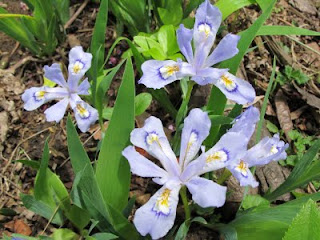
May is iris season in most places, but not only bearded iris.
Although Iris shows abound and these have everything from Intermediate to Tall Bearded Irises and an array or aril and aril bred Irises, there's so much more if you seek out variety.

The first are a couple of the crested iris species. I suppose everyone knows the 'story' of the so-called "Japanese Roof" Iris, Iris tectorum. It is not from Japan and it doesn't grow on roofs. Of course. The species is native to China where it is known simply as "Iris". It is common, wide spread, tolerates a range of growing conditions and the Japanese long ago brought plants from China to Japan where it escaped and settled down.
The story goes that in feudal Japan the Shogun and other powers mandated that only edible plants could be grown by the peasants. Although it is true that the ground rhizome of Iris tectorum is used to produce a fine quality of pale face powder, it is not true that women skirted the growing ban by cultivating this iris on Japanese thatch roofs to divert from the terrestrial restrictions. I imagine it CAN be grown in a thick thatch, but surely some wise ladies could find a spot in the corner of the rice fields or around a corner to stick a couple rhizomes of this lovely iris. What is true is that the first western botanists who 'discovered' this species fell hook line and sinker for this fairy tale.... and it does make a good story, one of those garden conversation starters.

The nice thing is that the iris is easy to grow, hardy and can be very floriferous when happy. The typical blue-violet color is remarkably consistent although a few named variants have been introduced over the years. The biggest variation is the nearly pure white 'Alba' form. Unlike many 'albas' it is equally vigorous and hardy. An added bonus is that it is easy from seed and the white form comes true. The SIGNA seed exchange almost always has seed available.

Although there really are varieties with variegated foliage, there are no named cultivars. A few different variegated patterns have been reported and at least one is occasionally offered for sale. It has white stripes in the foliage in early spring, but as summer approaches the variegation fades. It is a weak grower and poor bloomer compared to typical forms.
Iris tectorum is suited to all but the very coldest or hottest and driest gardens. It makes a good non-bearded specimen for the May Iris shows.
Quite comparable in many ways to this Asian beauty is the American native, Iris cristata , the Crested Iris. This species is native to a large part of the Central United States where it grows in thin soils in woodlands. It can form large mats of leaves dotted with flowers ranging from white, to blue to violet. Most gardeners find it fairly easy to grow in light shade and woodland soils.


Iris cristata is a near perfect educational 'point' for iris shows. It is so much tinier than most other entries, it has a distinct form and it is native to the United States. If your show has an "Artisitic Design' Section for small arrangements this species has a very high 'cute quotient' and is tailor made for that.

Even smaller and a bit trickier to grow is the Lake Iris, Iris lacustris, found around the Great Lakes of the United States in gravel and sandy spots under shoreline cedars. Like its relative the crested iris, it occurs in shades of blue, violet and white although the latter is quite rare. The whole species is rare and it is protected in many parts of its range. The Lake Iris grows in similar situations to the Crested Iris, but may be even hardier. As a cut flower in the Iris show it may bewilder many of the viewers. The gardener just has to keep track of it so it doesn't get over grown by more aggressive companions in the garden.

Of course the rarest of the rare are the historical reports of pink flowered Crested and Lake Irises. Both have been rumored, but neither plants nor pictures exist. We can only dream.
Meanwhile these medium, small and smallest crested iris are perfect garden and show conversations starters. And if all you grow is bearded irises of all sorts, you need to expand your growing horizons into these woodland wonders.